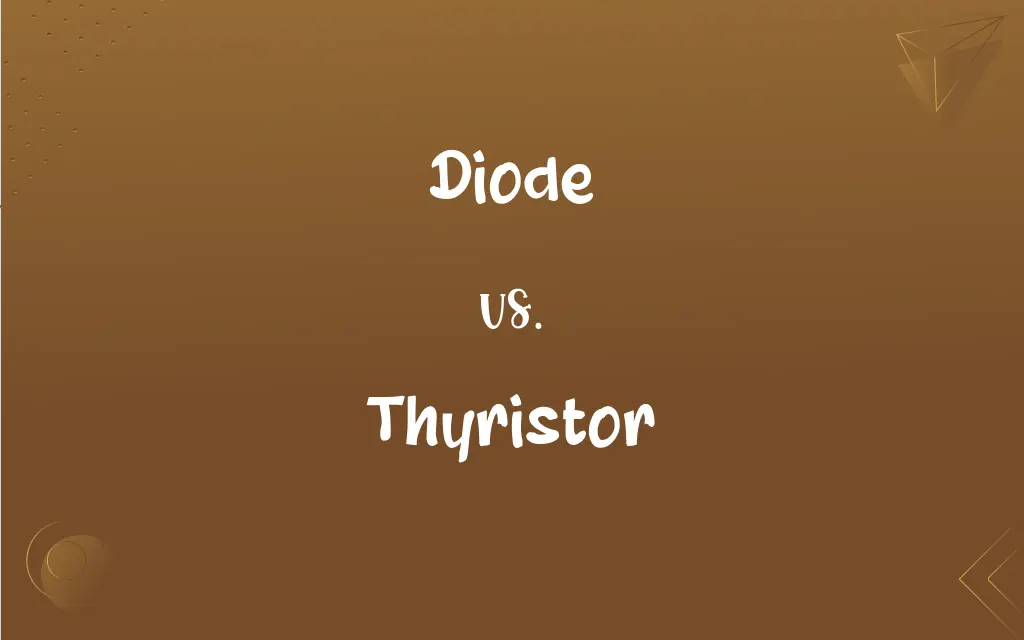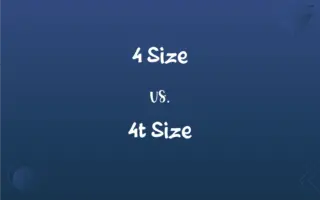Diode vs. Thyristor: What's the Difference?
Edited by Aimie Carlson || By Janet White || Published on March 27, 2024
A diode is a semiconductor device allowing current flow in one direction, while a thyristor is a four-layered semiconductor device used as a switch or to control high currents.

Key Differences
Diodes and thyristors are both crucial components in the field of electronics, each serving distinct purposes based on their unique properties. A diode, fundamentally a two-terminal device, allows current to flow primarily in one direction, acting as an electronic check valve. Thyristors, however, are more complex, consisting of four layers of semiconductor material that enable them to function as switches or to control high-power circuits, requiring a triggering signal at their gate to conduct.
Diodes are widely used for rectification in power supplies, converting alternating current (AC) to direct current (DC), thyristors find their applications in motor speed controls, light dimmers, and in power conversion circuits. The simplicity of diodes makes them ideal for tasks like signal modulation or demodulation and protection circuits against voltage spikes. Thyristors, with their ability to handle large voltages and currents, are better suited for applications requiring controlled power delivery or where rapid switching is not critical.
The operation of diodes is governed by the semiconductor materials' P-N junction, which inherently allows current to pass more easily in one direction than the reverse. Thyristors, alternatively, utilize a P-N-P-N structure and remain in an off state until a gate pulse is applied, after which they continue to conduct until the current through the device drops below a certain threshold.
In terms of control, diodes require no external signal to operate, automatically conducting when the forward voltage exceeds a certain level. Thyristors, on the other hand, need an external trigger to the gate terminal to start conducting, offering more control over the circuit operation. This makes thyristors particularly useful in circuits where the timing and duration of the current flow need to be managed.
Despite their differences, both diodes and thyristors share the fundamental characteristic of semiconductor devices, utilizing doped silicon or germanium to achieve their respective functionalities. While diodes are essential for basic rectification and signaling tasks, thyristors are indispensable in power electronics, providing controlled rectification and switching for complex electrical systems.
ADVERTISEMENT
Comparison Chart
Basic Structure
Two-layer (P-N junction)
Four-layer (P-N-P-N)
Function
Allows current flow in one direction
Acts as a switch, controlling high power circuits
Control
No external signal needed
Requires a gate signal to initiate conduction
Applications
Rectification, signal processing, protection
Motor control, light dimming, power conversion
Current Handling
Lower compared to thyristors
Higher, suitable for high power applications
ADVERTISEMENT
Switching Speed
Generally faster
Slower, due to more complex structure
Voltage Handling
Typically lower than thyristors
Higher, designed for high voltage applications
Complexity
Less complex
More complex due to additional layers
Conductivity
Conducts when forward-biased, without gate signal
Conducts only after gate signal, until current drops
Diode and Thyristor Definitions
Diode
A semiconductor device allowing current to flow in one direction.
The diode protected the circuit from reverse current damage.
Thyristor
Suitable for AC power control applications.
The AC heater's temperature was regulated by a thyristor.
Diode
Used in rectifying circuits to convert AC to DC.
We used a diode bridge to rectify the AC input in the power supply.
Thyristor
Remains off until triggered by a gate pulse.
The thyristor remained off until the control circuit sent a trigger pulse.
Diode
Essential for protecting circuits from voltage spikes.
A diode was placed across the relay coil to suppress voltage spikes.
Thyristor
Controls high power circuits with a gate signal.
We used a thyristor in the dimmer circuit to control the lamp's brightness.
Diode
Acts as an electronic check valve in circuits.
A diode ensured that the battery charged correctly without backflow.
Thyristor
A four-layer semiconductor device used as an electronic switch.
The thyristor switched on the motor when the gate received a pulse.
Diode
Can be used in signal modulation and demodulation.
The radio receiver used a diode for demodulating the incoming signal.
Thyristor
Can handle large voltages and currents in power circuits.
A thyristor was used to control the high current in the industrial furnace.
Diode
An electrical device, such as a semiconductor or electron tube, through which flow of current is generally restricted to one direction. Diodes are often used in or as rectifiers.
Thyristor
(electronics) A semiconductor diode having an extra "gate" terminal to switch it on.
Diode
(electronics) An electronic device that allows current to flow in one direction only; used chiefly as a rectifier.
Diode
A thermionic tube having two electrodes; used as a rectifier
Diode
A semiconductor that consists of a p-n junction
FAQs
What is a Zener diode?
A Zener diode is a type of diode designed to allow current to flow backwards when a specific, reverse voltage (Zener voltage) is reached.
What is a diode?
A diode is a semiconductor device that allows current to flow in one direction only, acting as an electronic check valve.
What are diodes made from?
Diodes are made from semiconductor materials, typically silicon or germanium, that have been doped with impurities to create a p-n junction.
What are the common types of diodes?
Common types include rectifier diodes, Zener diodes, Schottky diodes, and light-emitting diodes (LEDs).
How is a diode symbolized in circuit diagrams?
In circuit diagrams, a diode is symbolized as a triangle pointing towards a line, where the triangle represents the anode and the line the cathode.
What is forward bias in a diode?
Forward bias is the condition that allows current flow through a diode, achieved by applying a positive voltage to the anode relative to the cathode.
What are the common types of thyristors?
Common types include Silicon-Controlled Rectifiers (SCRs), Triacs, and Gate Turn-Off thyristors (GTOs).
How does a diode work?
A diode works by allowing current to flow easily from its anode to cathode but blocking current flowing in the reverse direction.
Can diodes convert AC to DC?
Yes, through a process called rectification, diodes convert alternating current (AC) to direct current (DC).
What is a thyristor?
A thyristor is a solid-state semiconductor device with four layers of alternating n and p-type material. It acts as a bistable switch, conducting when its gate receives a current pulse and continues to conduct while the voltage across the device is forward-biased.
What applications use thyristors?
Thyristors are used in power control applications, such as in variable-speed motor drives, dimmers, pressure control systems, and controlled power rectifiers.
What is a diode used for?
Diodes are used for rectification (converting AC to DC), voltage regulation, signal mixing, and in circuits as protection devices.
What is reverse bias in a diode?
Reverse bias is the condition that prevents current flow, achieved by applying a positive voltage to the cathode relative to the anode.
What is an SCR?
An SCR (Silicon-Controlled Rectifier) is a type of thyristor that can switch and control high power and is mainly used in AC and DC circuits for controlled rectification.
How is a thyristor controlled?
A thyristor is controlled by applying a pulse to its gate terminal, which allows it to switch from a non-conductive to a conductive state.
How do you turn off a thyristor?
Turning off a thyristor involves reducing the current flowing through it below a certain level, known as the holding current, or by applying a reverse voltage in specific types like GTOs.
How does a thyristor differ from a diode?
Unlike a diode, which conducts in one direction when forward-biased, a thyristor requires a gate signal to initiate conduction and can control large amounts of power.
Can thyristors be used in DC circuits?
Yes, thyristors can be used in DC circuits, primarily SCRs, for controlled rectification and as switches.
What is a Triac?
A Triac is a type of thyristor that can conduct current in both directions when triggered, making it suitable for AC applications.
What determines a thyristor’s switching speed?
A thyristor’s switching speed is influenced by its design and material properties. SCRs generally have slower switching speeds compared to other semiconductor devices like MOSFETs.
About Author
Written by
Janet WhiteJanet White has been an esteemed writer and blogger for Difference Wiki. Holding a Master's degree in Science and Medical Journalism from the prestigious Boston University, she has consistently demonstrated her expertise and passion for her field. When she's not immersed in her work, Janet relishes her time exercising, delving into a good book, and cherishing moments with friends and family.
Edited by
Aimie CarlsonAimie Carlson, holding a master's degree in English literature, is a fervent English language enthusiast. She lends her writing talents to Difference Wiki, a prominent website that specializes in comparisons, offering readers insightful analyses that both captivate and inform.







































































